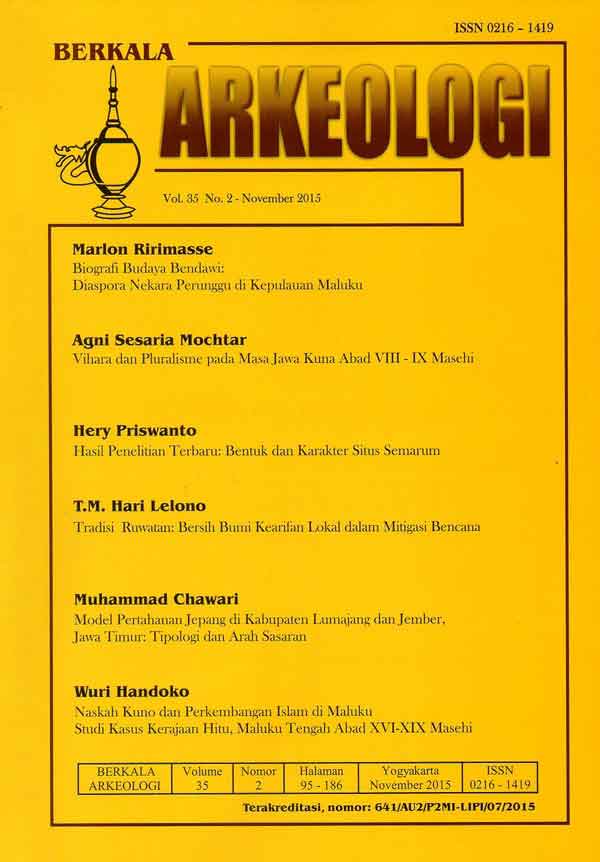TRADISI RUWATAN: BERSIH BUMI KEARIFAN LOKAL DALAM MITIGASI BENCANA
Main Article Content
Abstract
Tradition worship of ancestral spirits in Tengger occur along with the megalithic culture that is widespread in Indonesia, around 500 BC - 500 AD. Physical culture can be seen the remains of objects such as menhirs, and terraces devoted to the concept of ancestral spirit worship followed by a tradition in the community concerned. Megalithic tradition for a group of tribes, is devoted to the worship of ancestral spirits as ruler of protecting and giving life. Therefore, the purpose of this paper is to determine the Tengger local wisdom in maintaining natural ecosystems by humans, through a tradition that has lasted for generations can overcome the problem of frequent disasters. Efforts are being made in the search for the data to answer these goals, used the method of approach by conducting interviews and observations of one tradition that held that ceremony mayu desa / ruwatan. The ceremony is conducted once a year, but in year five held over the highway at the expense of a buffalo or cow. From the results of these interviews, the data obtained with regard to the meaning, function and purpose of the ceremony mayu desa / ruwatan, related to disaster mitigation issues.
Article Details

This work is licensed under a Creative Commons Attribution-NonCommercial-ShareAlike 4.0 International License.
References
Bemmelen, R.W. van. 1949. The Geology of Indonesia, Vol.I. General Geology of Indonesia and Adjecent, Government Printing Office, The Hague.
Hole. Frank and Robert F. Heizer.1973 An Introduction to Prehistoric
Archaeology 3nd editions, New York: Holt, Rinehart and Winston Inc.,
Istari, Rita. 2009. Arsitektur Candi Sanggar Di Lereng Gunung Bromo Kabupaten Pasuruan (Tahap IV). Laporan Penelitian Arkeologi (LPA). Balai Arkeologi Yogyakarta.
Koentjaraningrat, 1981. Pengantar Ilmu Antropologi. Aksara Baru, Jakarta.
Nababan, A. 1995. Kearifan Tradisional dan Pelestarian Lingkungan Hidup di Indonesia. Analisis CSIS, Th XXIV, No.6.,Nov-Des.
Prasetyo,. Bagyo, Dwi Yani Yuniawati (ed).2004. Religi pada Masyarakat Prasejarah di Indonesia. Kementerian Kebudayaan dan Pariwisata. Proyek Penelitian dan Pengembangan Arkeologi, Jakarta.
Soejono, R.P., 1984. “Jaman Prasejarah di Indonesiaâ€, dalam Sejarah Nasional Indonesia, Vol.I.PN Balai Pustaka, Jakarta.
Subalidinata, RS. 1982. Nilai-Nilai Tradisional yang Tercermin dalam Sastra Budaya Jawa (Fungsi dan Tugasnya). Makalah pada Saresehan Nilai Kesejarahan dan Nilai Tradisional. Yogyakarta: Balai Kajian Sejarah dan Nilai Tradisional, Depdikbud.
Sukarto, MM. 1989. Ruwatan Merapi sebuah Tradisi. Paper. Dalam Lembaga Javanologi Yayasan Panunggalan. Yogyakarta. 1998.
Suyami, dkk. 2015. Kajian Kebencanaan dalam Naskah Panjeblugipun Redi Kelud, Seminar Proposal Penelitian, 24-25 Februari 2015. Balai Pelestarian Nilai Budaya Yogyakarta.
Sumintarsih, dkk. 2005. Kearifan Lokal di Lingkungan Masyarakat Nelayan Madura. Balai Kajian Sejarah dan Nilai Tradisional Yogyakarta.
Kementerian Kebudayaan dan Pariwisata.
Watson, Patty Jo. Steven A.Le Blanc. Charles L. Redman.1971. Explanation in Archaeology: An Explicity Scientific Approaach. New York: Colombia
University Press.
Kamus Besar Bahasa Indonesia, 2012. Departemen Pendidikan dan Kebudayaan. PT Gramedia Pustaka Utama, Jakarta.
http://lipsus.kompas.com/jalanjalan/read/2010/11/09/04270659/Ritual..quot.Ruwat.Tolak.Bala.quot..untuk.Merapi/ Diunduh pada tanggal 10 maret 2015. Pukul 09.35 WIB.

